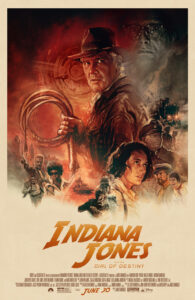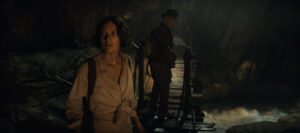Film Review: Messy but Fun “Indiana Jones and the Dial of Destiny” Ends Well
Written by: Christopher Llewellyn Reed | June 29th, 2023

Indiana Jones and the Dial of Destiny (James Mangold, 2023) 2½ out of 4 stars.
Ever since the first Indiana Jones film, the 1981 Raiders of the Lost Ark, came out, I have held out hope that other movies might hold the same exciting mix of action, adventure, comedy, and romance that so inspired me as a child. As an adult, I have come to recognize the many lazy colonialist and racist stereotypes within that early Steven Spielberg work, yet the cinematic glory of its other aspects still holds my imagination. The first sequel—the 1984 Indiana Jones and the Temple of Doom—proved a sore disappointment, but the third entry in the franchise—the 1989 Indiana Jones and the Last Crusade—aided by the delightful charm of Sean Connery as Indy’s father, renewed my faith in the series. The less said about the 2008 Indiana Jones and the Kingdom of the Crystal Skull, the better (although it did mark the delightful return of Karen Allen as Marion Ravenwood).
Now, 15 years after that last misbegotten episode, we have Indiana Jones and the Dial of Destiny. The now-octogenarian Harrison Ford is back, but Spielberg has turned the directorial reins over to James Mangold (Logan). There is much to like here, with new addition Phoebe Waller-Bridge (Amazon’s Fleabag series), as a new character, foremost among them. The movie also comes with a seemingly limitless desire to excite, and even if not all moments work, the spirit is infectious. If not at the level of #1 and #3, Mangold’s effort stands well above #2 and #4. Damning with faint praise? Not at all. It has plenty of spunk to spare.

This time around, we first meet our hero in 1944, with Nazis, as ever, at the root of the problem. De-aged via software, Ford (as Indiana, or Indy)) may sound gruff, but more or less looks the part of a fortysomething man as he rides a motorcycle, runs atop a moving train and, of course, wields his trusty bull whip and wears his trademark fedora with style. He’s joined in this opener by a new sidekick, Basil Shaw (Toby Jones, First Cow), and pursuing a new villain, Dr. Voller (Mads Mikkelsen, Another Round). All of them are trying to obtain this film’s supernatural device, the Antikythera, created by ancient Greek mathematician Archimedes. This is the titular dial, which can somehow act as a time machine. Too bad it falls into a river at the end of the sequence.
Flash forward to 1969, where we now get Ford looking his current self (even if playing a man around retirement age), about to step down as an archaeology professor at New York’s Hunter College and living in a ramshackle apartment on his own. What happened to the son we met in the previous film, and to Allen’s Marion, with whom he reunited? Patience is a virtue, my friend, though let’s just say that Mangold and company found a convenient way to deal with the Shia LaBeouf problem (he played the son last time), and one that here heightens the emotional stakes in a meaningful manner.

Before long, the curmudgeonly Indy, whose teaching and allure to students are definitely not what they once were, finds himself back in the game, courtesy of Shaw’s daughter (and Indy’s god-daughter), Helena (Waller-Bridge), as well as the return of Voller, with that missing (or is it?) dial at the center of it all. Nazis in New York in 1969? How could that be? Mangold makes it work, including a vicious dig at the rehabilitation of real-life Nazi—and (for better or worse) NASA visionary—Wernher von Braun, a pretty obvious inspiration for Voller. Not only are we in 1969, but it’s just after the moon landing, and celebrations are in order.
These lead to a pretty terrific chase scene through a Manhattan parade, combining cars and a horse, gunfire, and other manic shenanigans. There will be more such cleverness ahead. Unfortunately, there will also be quite a lot of collateral death, more than in the earlier films (at least of characters we get to know, as there has always been significant killing of extras, especially people of color). Being a friend to Indiana Jones proves quite fatal, and it’s not particularly pleasant to experience.

But the arc of the narrative has real dramatic heft, even as Mangold traffics in some of the same unfortunate Spielbergian tropes using denizens of the African continent as exotic and flamboyant background (with the Welsh John Rhys-Davies returning as the Egyptian Sallah). Fortunately there’s also a plucky young Moroccan kid in the mix, Teddy (Ethann Isidore), who comes with some solid agency of his own. But really, as much as this is an Indiana Jones movie, it’s Waller-Bridge’s show, and she more than delivers, helping to smooth out the many rough and uncomfortable spots.
Best of all, Indiana Jones and the Dial of Destiny gives its protagonist a poignant conclusion, wrapping up the story in a mostly satisfying bow that also gives Allen a chance to shine. The film is far from a masterpiece, but it contains plenty of entertainment value and many thrills (if violent ones). It’s a good place to end. I think we can let Indy go now.


